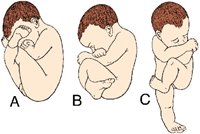Breech presentation at term
What is breech presentation?
Breech presentation is when your baby is presenting bottom or feet first, rather than head first. Approximately three per cent of babies are breech at term (37 to 42 weeks).
What are the types of breech presentation?
A. Frank (or extended) breech—legs are straight and feet are up near your baby’s head.
B. Complete (or flexed) breech—knees are bent, but feet are above your baby’s bottom.
C. Footling breech—feet are below your baby’s bottom.
What are the causes of breech presentation?
Breech presentation is more common in conditions such as:
- multiple pregnancy
- placenta praevia
- too much, or too little, amniotic fluid
- uterine abnormalities or pelvic masses
- certain conditions of your baby.
An ultrasound will be performed to exclude any of these reasons; however, more commonly than not, no specific cause is identified.
What are the risks for my baby or me?
If your baby presents as breech at term there is an increased risk of you needing a caesarean birth or having a complicated vaginal birth. Studies about the risks of breech presentation for both mother and baby show that, in certain situations, it can be safe to birth vaginally. However, there are some situations that will increase the risks for your baby. A caesarean birth also has increased risks for you compared to a vaginal birth. Therefore, all risks must be carefully considered when deciding what management option is right for you and your baby.
The lowest risk type of birth, for both mother and baby, is usually a vaginal birth where the baby is head first. Attempts to encourage your baby to turn will form part of the care which may be offered to you.
What is the chance of my baby turning spontaneously?
During pregnancy, many babies are in the breech position; however, most of these turn spontaneously before 37 weeks. If your baby is still breech at 37 weeks the chances of your baby turning by itself are considered to be low; therefore, you will have an opportunity to discuss the implications of this for your birth plan and what options are available to you.
What are my options?
Option 1 - External cephalic version
External cephalic version (ECV) is recommended, when no contraindication exists, as it can reduce the need for a caesarean birth. ECV is a commonly practiced procedure with a low risk of complications and a success rate of approximately 60 per cent. This procedure is carried out in the ultrasound department and your baby's heart rate will be monitored before, and after, the ECV. For further information about ECV please refer to Mater’s brochure: Pregnancy—external cephalic version.
Should you not be suitable for, or decline, an ECV or if you have an unsuccessful ECV, the risks and benefits of options two and three will be discussed with you to enable you to make an informed choice about how your baby will be birthed.
Option 2 - Vaginal breech birth
Your doctor will discuss with you whether you are suitable for a planned vaginal breech birth. Although the risks of a complicated birth are greater with breech presentation in general, studies have shown that, in carefully selected situations, outcomes for breech babies born vaginally are similar to those born by caesarean section.
You may be suitable for a vaginal breech birth if:
- you go into spontaneous labour
- the estimated weight of your baby, following ultrasound scan, is between 2500 g and 3800 g
- your baby is in either a complete (flexed) or frank (extended) breech presentation
- an ultrasound scan confirms your baby’s neck is not over-extended
- the size and shape or your pelvis is adequate
- there are no other antenatal complications which may increase the likelihood of a difficult birth.
During labour continuous monitoring of your baby’s heart rate is recommended and regular assessment of the progress of your labour is important.
Option 3 - Elective caesarean birth
If there are reasons specific to you or your baby why a planned vaginal breech birth is not advised or, if after discussion, your preference is for planned caesarean birth, this is usually performed after 39 weeks. For further information about caesarean births please refer to Mater’s brochure: Caesarean birth.
What if I am in labour with a breech presentation?
If you are first diagnosed with a breech presentation in labour, or you present in labour prior to a booked elective caesarean birth your options will be discussed with you. An emergency caesarean birth carries additional risks for you and may provide no additional benefit to your baby in certain circumstance. The decision to perform an emergency caesarean birth or to proceed with a vaginal breech birth will depend on circumstances such as the type of breech, other antenatal risk factors and the stage and progress of your labour.
Are there other ways of turning my baby?
There are many alternative therapies that women may try to turn a breech baby. While none of these have been proven to be effective, in general these therapies carry no significant risk.
Mater acknowledges consumer consultation in the development of this patient information.
Mater Doc Num: PI-CLN-430133
Last modified 14/11/2017.
Consumers were consulted in the development of this patient information.
Last consumer engagement date: 18/10/2017
For further translated health information, you can visit healthtranslations.vic.gov.au/ supported by the Victorian Department of Health and Human Services that offers a range of patient information in multiple languages.